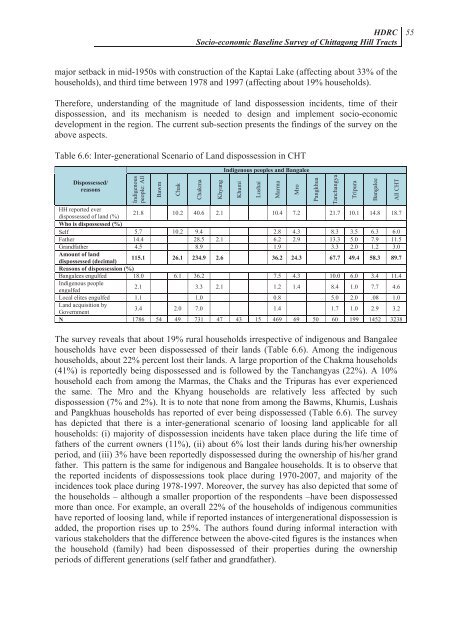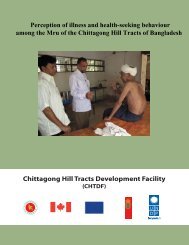Socio-economic Baseline Survey of Chittagong Hill Tracts - chtdf
Socio-economic Baseline Survey of Chittagong Hill Tracts - chtdf
Socio-economic Baseline Survey of Chittagong Hill Tracts - chtdf
- No tags were found...
You also want an ePaper? Increase the reach of your titles
YUMPU automatically turns print PDFs into web optimized ePapers that Google loves.
HDRC<strong>Socio</strong>-<strong>economic</strong> <strong>Baseline</strong> <strong>Survey</strong> <strong>of</strong> <strong>Chittagong</strong> <strong>Hill</strong> <strong>Tracts</strong>55major setback in mid-1950s with construction <strong>of</strong> the Kaptai Lake (affecting about 33% <strong>of</strong> thehouseholds), and third time between 1978 and 1997 (affecting about 19% households).Therefore, understanding <strong>of</strong> the magnitude <strong>of</strong> land dispossession incidents, time <strong>of</strong> theirdispossession, and its mechanism is needed to design and implement socio-<strong>economic</strong>development in the region. The current sub-section presents the findings <strong>of</strong> the survey on theabove aspects.Table 6.6: Inter-generational Scenario <strong>of</strong> Land dispossession in CHTDispossessed/reasonsIndigenouspeople: AllBawmChakChakmaKhyangIndigenous peoples and BangaleeHH reported everdispossessed <strong>of</strong> land (%)21.8 10.2 40.6 2.1 10.4 7.2 21.7 10.1 14.8 18.7Who is dispossessed (%)Self 5.7 10.2 9.4 2.8 4.3 8.3 3.5 6.3 6.0Father 14.4 28.5 2.1 6.2 2.9 13.3 5.0 7.9 11.5Grandfather 4.5 8.9 1.9 3.3 2.0 1.2 3.0Amount <strong>of</strong> landdispossessed (decimal)115.1 26.1 234.9 2.6 36.2 24.3 67.7 49.4 58.3 89.7Reasons <strong>of</strong> dispossession (%)Bangalees engulfed 18.0 6.1 36.2 7.5 4.3 10.0 6.0 3.4 11.4Indigenous peopleengulfed2.1 3.3 2.1 1.2 1.4 8.4 1.0 7.7 4.6Local elites engulfed 1.1 1.0 0.8 5.0 2.0 .08 1.0Land acquisition byGovernment3.4 2.0 7.0 1.4 1.7 1.0 2.9 3.2N 1786 54 49 731 47 43 15 469 69 50 60 199 1452 3238The survey reveals that about 19% rural households irrespective <strong>of</strong> indigenous and Bangaleehouseholds have ever been dispossessed <strong>of</strong> their lands (Table 6.6). Among the indigenoushouseholds, about 22% percent lost their lands. A large proportion <strong>of</strong> the Chakma households(41%) is reportedly being dispossessed and is followed by the Tanchangyas (22%). A 10%household each from among the Marmas, the Chaks and the Tripuras has ever experiencedthe same. The Mro and the Khyang households are relatively less affected by suchdispossession (7% and 2%). It is to note that none from among the Bawms, Khumis, Lushaisand Pangkhuas households has reported <strong>of</strong> ever being dispossessed (Table 6.6). The surveyhas depicted that there is a inter-generational scenario <strong>of</strong> loosing land applicable for allhouseholds: (i) majority <strong>of</strong> dispossession incidents have taken place during the life time <strong>of</strong>fathers <strong>of</strong> the current owners (11%), (ii) about 6% lost their lands during his/her ownershipperiod, and (iii) 3% have been reportedly dispossessed during the ownership <strong>of</strong> his/her grandfather. This pattern is the same for indigenous and Bangalee households. It is to observe thatthe reported incidents <strong>of</strong> dispossessions took place during 1970-2007, and majority <strong>of</strong> theincidences took place during 1978-1997. Moreover, the survey has also depicted that some <strong>of</strong>the households – although a smaller proportion <strong>of</strong> the respondents –have been dispossessedmore than once. For example, an overall 22% <strong>of</strong> the households <strong>of</strong> indigenous communitieshave reported <strong>of</strong> loosing land, while if reported instances <strong>of</strong> intergenerational dispossession isadded, the proportion rises up to 25%. The authors found during informal interaction withvarious stakeholders that the difference between the above-cited figures is the instances whenthe household (family) had been dispossessed <strong>of</strong> their properties during the ownershipperiods <strong>of</strong> different generations (self father and grandfather).KhumiLushaiMarmaMroPangkhuaTanchangyaTripuraBangaleeAll CHT



